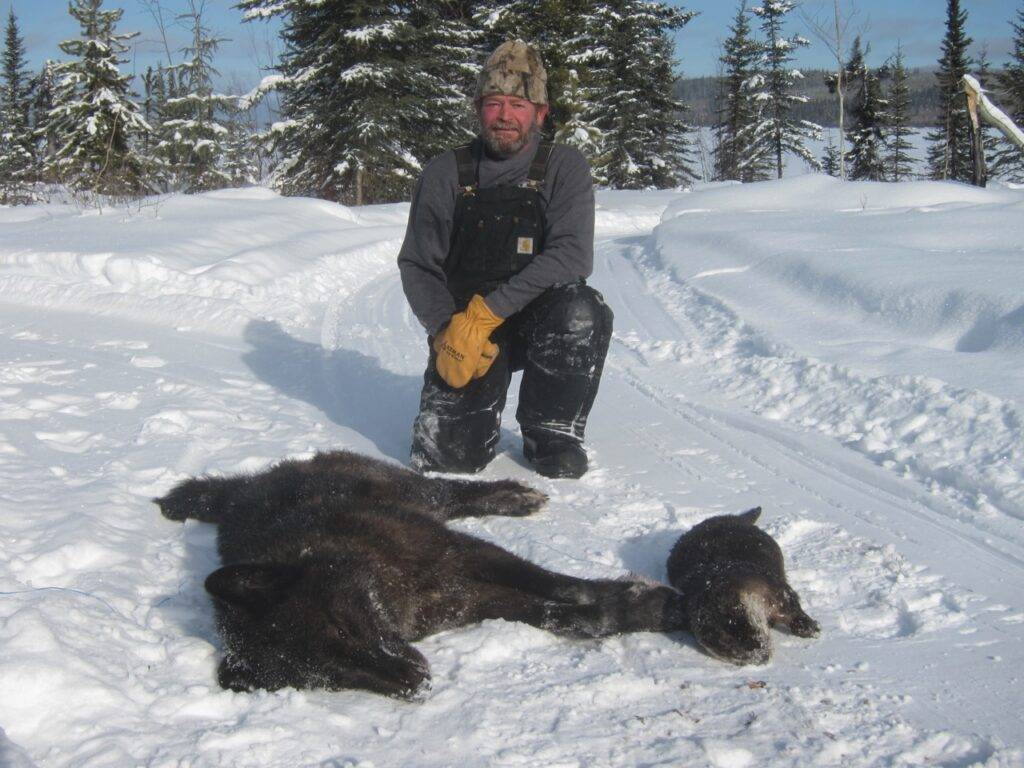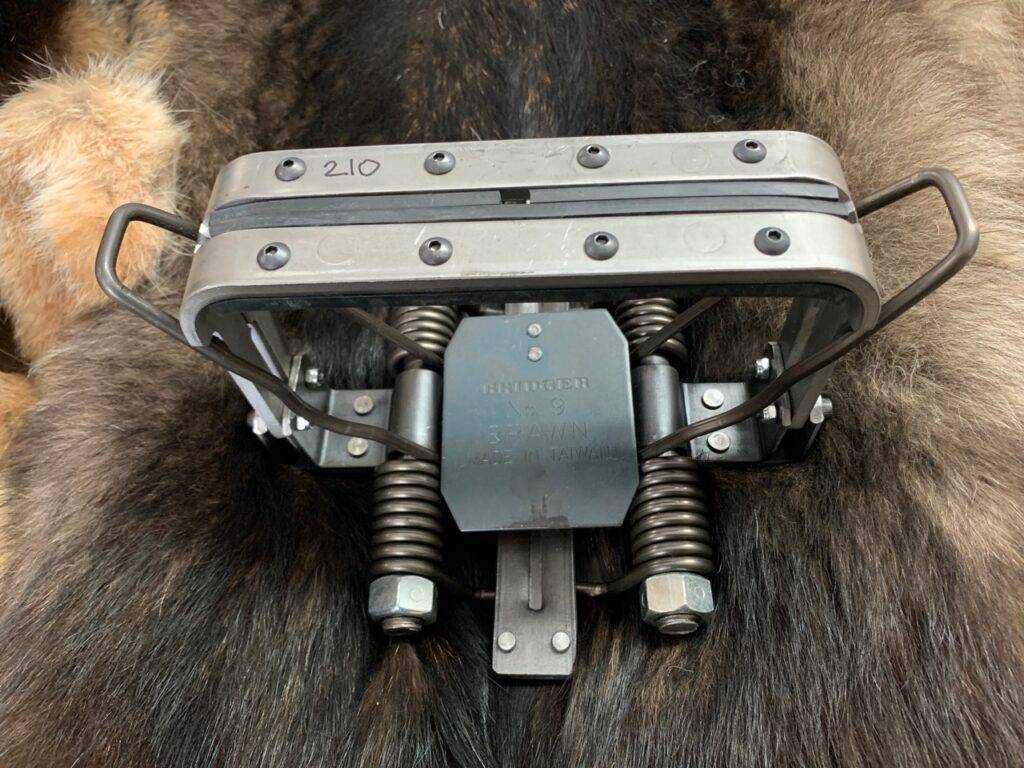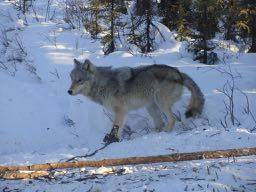As an Amazon Associate I earn from qualifying purchases.
The Art of Wolf Trapping: Tips and Techniques for Success

Wolf trapping can be a challenging hobby. Wolves have an uncanny ability to sense a dangerous situation, and they will learn from a single experience. I’ve seen them do things that are hard to believe. One winter, three wolves moved into the valley near my cabin in late November. They were the survivors of a large pack to the south that another trapper had been targeting. They wouldn’t go near a baited set of any kind.
I knew they were hungry because they were hunting muskrats on small lakes near the cabin. Muskrats under the ice are a tough way for a large carnivore to make a living, but those wolves had figured it out. Their tracks in the snow told the story. They would fan out across the ice looking for muskrat push-ups. Once they located an active push-up, they would dig it open, lay down, and wait. When a muskrat popped up, they were close enough to grab it. Blood around the holes proved they were successful. Their tactics required keen senses and a whole lot of patience.
An Educated Wolf is Harder to Catch
The most important lesson I’ve learned in a lifetime of wolf trapping is this; an educated wolf is much harder to catch. I do everything possible to avoid educating them. Wolves are naturally wary of anything unusual, and their sense of smell is in a league of its own.
One of the biggest mistakes a wolf trapper can make is to go out with a box full of wolf traps without a plan. Fresh sets have the potential to educate wolves faster than anything else. No matter how hard we try, making a wolf set without leaving scent in the area is almost impossible.
Time is a trapper’s best friend when it comes to wolf trapping. The longer a set is left out in the elements undisturbed, the less scent and human sign there will be. I could count on one hand the number of wolves I’ve caught in fresh sets.
I watch the weather closely during trapping season and try to get my wolf sets out right before a snowfall. A few inches of fresh snow over a wolf set erases any sign I might have left behind.
Wolf Trapping is Easier When You Know Their Travel Patterns
A single pack of wolves will have a home territory of many square miles in size. The size of these areas usually depends on the density of ungulate populations. Generally speaking, territory size will be smaller in areas with a high density of prey species. Here in the Yukon, where I trap, a single pack of wolves needs a lot of ground to survive. Their home territory can be so large that it might take them weeks to come through a particular area.
Identifying a wolf pack’s home territory and travel patterns is the key to successful wolf trapping. They will use the same travel routes year after year. A trapper can quickly understand how wolves travel throughout their territory by studying their sign. This knowledge gives you a huge advantage. Remember that wolves use an area differently during the summer than they will during the winter months.
My tactic is to get my sets made BEFORE wolves come through an area. Ideally, at least a week before, they might show up. A few days in the elements makes a big difference. Any scent I leave behind will have time to dissipate, and the elements will erase any sign I may have left.
Accessories That Will Make Wolf Trapping Easier
Although I’m a big believer in keeping gear and equipment as simple as possible, there are a few accessories that are must-have items for a serious wolf trapper. A good pair of trap setters is at the top of the list. Wolf traps are powerful, and the last thing you want to do is get a hand caught or struggle around a set trying to set your trap.
One HandTrap setters are the best trap setters I’ve ever used. These setters will work for all the large coil spring traps; I’ve even used them for long springs.
A sheet metal cookie cutter is another tool that makes wolf trapping easier. They are used to cut a hole in hard-packed snow. Think snowmobile trails. The first one I saw was at a wolf trapping seminar in Fairbanks, Alaska. A cookie-cutter looks like a cutter a chef uses to cut cookies. Slightly larger than a wolf trap, the cutter neatly cuts through hard snow. Then all you need to do is lift the “snow cookie” out and have a hole to bed your trap in.
My wolf-trapping box always includes a small garden shovel and a dust broom. I use the shovel for bedding traps, and the broom is ideal for blending the snow around sets.
3 of The Best Wolf Traps on The Market Today
Bridger Brawn #9 Wolf Trap

The Bridger Brawn #9 is a large wolf trap. This dog-less trap is available with padded or laminated offset jaws. A unique spring design incorporates an acceleration ramp that makes the Bridger Brawn #9 one of the fastest wolf traps on the market.
Koro #9 Wolf Trap
Designed by James Korosil, the Koro #9 is manufactured in Canada. I was involved in the initial testing of this trap, which is an absolute powerhouse. Like the Brawn, the Koro is also a dogless design. The Koro has an 8.5 x 9-inch jaw spread when set and the jaws are made out of hardened wear-resistant steel. Grade 8 bolts with stover lock nuts secure the jaws to the frame. The music wire springs are made in-house. I have a lot of experience with the Koro wolf trap and to date, I’ve never seen one damaged in any way by a wolf.
No BS Extreme Wolf Trap
A relative newcomer in the lineup of legholds suitable for wolves is the K.O.-X-treme wolf trap. No BS Extreme traps are handmade in the USA and have gained a large following in just a few years for good reason. They are tough no-nonsense traps. Featuring ¼ inch-thick steel frames and jaws, these traps are a dogless design with a pan block welded onto the inside of the jaw. This allows the pan to sit below the jaws and makes NO BS traps one of the easiest traps to bed. The K.O. X-treme wolf traps have an 8.5-inch jaw spread and the pan features a night latch design. Jaws are bolted in to eliminate any chance they will pop out and both levers and jaws are heat treated.
You can buy these traps with confidence. NO BS traps are built like a tank and will last a lifetime.
Preparing Wolf Traps for the Field
Wolf traps should be waxed and dyed. Wax not only protects a trap; it also speeds them up. Speed can be the difference between a catch and a miss. I use Pete Rickard’s trap wax, you can get it here.
What color you dye your wolf traps will depend on your location. A dark trap is the better choice if you are trapping on dry ground. White is the best choice for traps used in snow.
A dark trap will soak up solar heat in the snow, especially when set out on the open ice. If traps warm up enough, the snow over them will melt faster than in the surrounding area, and they can become quite visible. White dye solves this problem.
I’ve been using Andy Stoe’s Speed Dip for years and find it works well.
Chain and Drags

There are a variety of ways to anchor a wolf trap. One of the oldest methods is a wooden pole 6 feet long and at least 3 inches in diameter. The downside to wooden drags is that they are more complicated to hide than other systems.
I rig my wolf traps with eight to ten feet of #5 straight link chain and two crunch-proof swivels. The first swivel should be seven to ten inches from the baseplate of the trap. A second swivel midway down the chain will prevent twists should the first swivel fail. It’s also an excellent idea to spot-weld the swivels closed.
A two or three-prong drag is the most versatile drag you can use. These drags are easy to transport and will work in just about any location.
Ice anchors work well on lakes and rivers. To anchor a trap in the ice, chop a small hole a few inches deep and drop in a few chain links. Pour some water into the hole, and your trap will be anchored solid enough to hold the largest wolf when it freezes.
I like to do all my trap maintenance in the spring. Wolf traps are repaired as needed and then dyed and waxed. Then I let them hang outside all summer, and they are as scent-free as they will get by fall.
Lures for Wolves
I use lures sparingly on wolf sets because wolves will learn to identify and avoid them. Since wolves travel together so often, other wolves almost always witness a catch, and they are smart enough to associate the smell of a lure with danger.
I use lures to some extent, but I’m careful to use them sparingly.
Wolf urine, gland lures, and raw sheep’s wool work well for me. It’s essential to use pure wolf urine. You can either buy it or harvest it from wolves you catch yourself. Amazon sells pure wolf urine. You can check prices here.
There are a variety of commercially available wolf gland lures on the market. I’ve been using Caven’s “Yodel Dog” gland lure for a few years now, and although it’s a coyote lure, it works well for wolves too.
Surprisingly raw sheep’s wool all by itself will attract wolves as well as anything. Even here in the Yukon, where there are no domestic sheep.
The Top 3 Producing Wolf Sets
Blind sets are far and away the most productive leghold sets I make for wolves. A blind set is a trap in a trail anywhere you think a wolf will travel. No bait, lure, or other attractor is used. Trap placement with blind sets is important, especially on wide trails like snowmobile tracks. Wolves will usually travel down the center of a trail, so place your trap as close to the center as you can.
The Urine Post Set for Wolves
The urine post set is as old as trapping itself. Canines (including dogs) can’t resist peeing on certain things that strike their fancy. Some trappers feel that wolves do it to mark their territory. That could be true sometimes, but they will also use a pee post throughout their territory. The reason they do it is less important than the fact that they do so regularly that a urine post set is a top producer.
A urine post can be either natural or manufactured. Almost anything will work to make one. A stump, a tuft of grass, or even a tall block of ice will work.
Place an object off to the side of a trail to make a urine post set. Bed your wolf trap in front of the object. The idea is to catch a wolf as it walks up to pee on the object you placed there. Some trappers will set their trap against the pee post, but I like to bed mine out about ten inches.
With my trap bedded and blended with snow, I squirt a liberal amount of wolf urine on the ‘pee post.’ If you plan your sets carefully, you can add urine without disturbing the set. I make mine close enough to my snowmobile trail that I can add fresh urine without ever getting off the machine.
Gland Lure Set for Wolves
A gland lure set for wolves is similar to a dirt hole set coyote trappers use. With my garden shovel, I dig a fist-sized hole in the snow and put a few drops of gland lure down in the hole. I like to bed my trap up tight against the hole with a gland set.
I make these sets with something behind them, so I have control over how a wolf will approach the set. A bush or a snowdrift works well. Raw sheep’s wool is a good substitute for gland lure, and it’s a good idea to switch it up occasionally.
Handling Wolf Pelts for Profit
Good quality wolf pelts bring a good price at the fur auction if appropriately handled. The biggest mistake trappers make is not skinning them for taxidermy. If you expect to get top prices, you must learn to skin for taxidermy. A large wolf pelt with good fur will sell for $800 to $1000, so it’s worth learning to skin them properly.
Wolf trapping can be challenging, but the more you learn about these large canines, the more successful you will be. Thanks to legendary trappers like the late Paul Kirkseater and Dean Wilson, the road to success is a lot shorter than it once was.
Few animals create as much controversy as the wolf. Wolves are a hot-button issue everywhere these days. It’s not my intention to validate wolf trapping with this post. The men and women who spend time on the land understand the value of managing these large predators sustainably.
Amazon and the Amazon logo are trademarks of Amazon.com, Inc, or its affiliates.